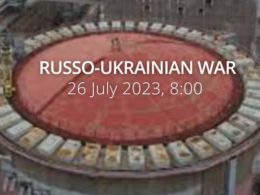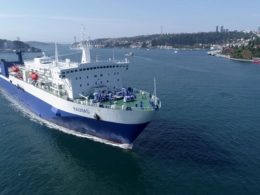August 23 - DAY OF THE NATIONAL FLAG!
Today more than ever the Ukrainian flag stands for Freedom and Independence.
So, our guys somewhere in the war zone got together to wish our readers, friends and followers a strong and brave blend of blue and yellow...#blueandyellow pic.twitter.com/JHJ0R98Wsj
— Euromaidan Press (@EuromaidanPress) August 23, 2022
The General Staff’s operational update regarding the Russian invasion as of 06.00 am, August 23, 2022 is in the dropdown menu below.
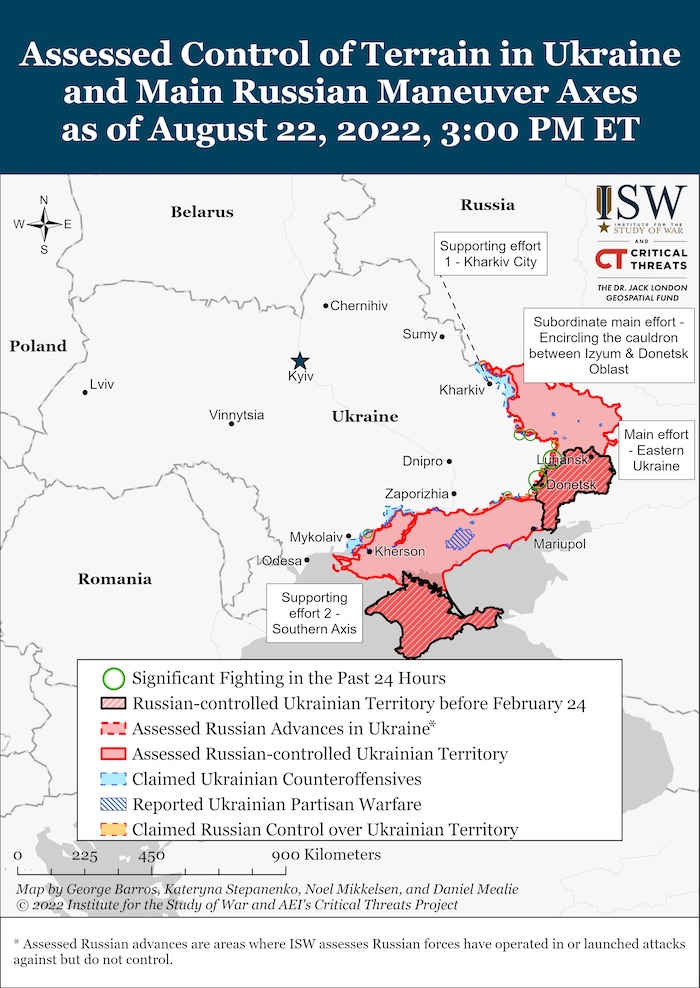
“[Russian forces continue to focus its efforts on establishing full control over the territory of Donetsk oblast, holding the captured districts of Kherson, part of Kharkiv, Zaporizhzhia, and Mykolaiv regions, restoring the combat capability of units that have suffered losses, and preventing a possible counteroffensive of the Defence Forces.]
[Air and missile strikes on civilian objects on the territory of Ukraine continue.]
[In the Volyn and Polissya directions, the situation remains without significant changes, units of the Armed Forces of the Republic of Belarus continue to carry out the task of strengthening the protection of the section of the Belarusian-Ukrainian border in the Brest and Gomel regions. The threat of Russian forces launching missiles and air strikes from the territory and airspace of the Republic of Belarus remains.] Russian forces are actively using means of radio-electronic warfare in the border areas.
In the Siversky direction, Russian forces fired barrel artillery at civilian and military infrastructure in the settlements of Chernihiv and Sumy oblast. [Russian forces continue to hold separate units of the Western Military District in the border areas of the Bryansk and Kursk regions to demonstrate the presence and constrain the actions of units of the Defense Forces. Yesterday, Russian forces fired from barrel artillery in the areas of Senkivka and Mykolaivka settlements of Chernihiv oblast and Katerynivka and Oboda of Sumy oblast.]
In the Slobozhansky direction, Russian forces are conducting combat operations to hold previously occupied areas and borders and are trying to improve the tactical position. [Russian forces are taking measures to equip and replenish the losses of personnel and military equipment.]
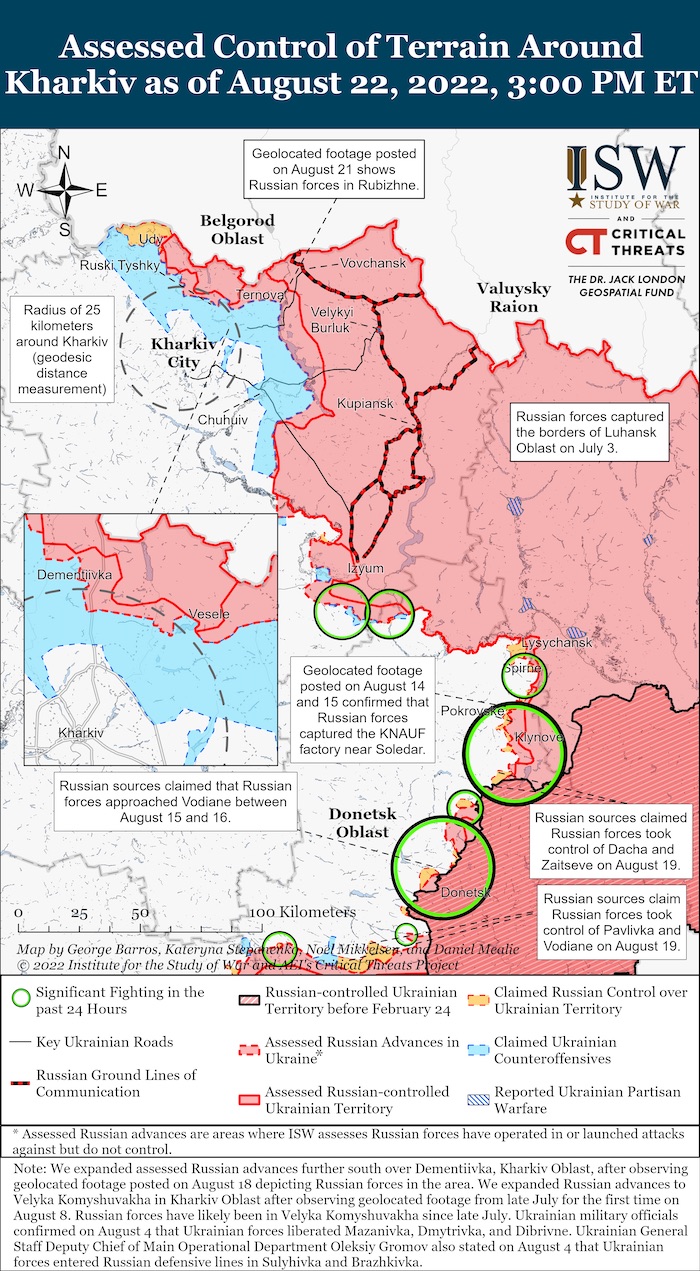
- [In the Kharkiv direction, Russian forces maintain a high intensity of UAV reconnaissance. Yesterday, they fired military and civilian infrastructure in the areas of Udy, Bazaliivka, Slobozhanske, Duvanka, Peremoha, Velyki Prohody, Ruska Lozova, Lebyazhe, Mospanove, Husarivka, Ruski Tyshky. Carried out airstrikes near Stary Saltov, Verkhnyi Saltov, Pytomnyk, Mospanove, and Husarivka.] Russian forces shelled the areas of Odnorobivka, Sosnivka, Tsupivka, Nove, Zamulivka, Dokuchayevske, Pytomnyk, Staryy Saltiv, Velyka Rohan and Ivashki settlements with artillery and MLRS. Airstrikes near Pytomnyk and Mospanove. UAV was used to scout the positions of our troops and adjust artillery fire.
- [In the Sloviansk direction, Russian forces yesterday carried out fire damage from tanks, barrel artillery, and MLRS near Krasnopilla, Mazanivka, Novaya Dmytrivka, Chepil, Bogorodichne, and Kurulka.] Russian forces carried out fire damage from tanks, barrel artillery, and anti-aircraft guns near Nortsivka, Krasnopilla, and Dolyna. An airstrike was carried out by an airstrike of Bohorodychne.
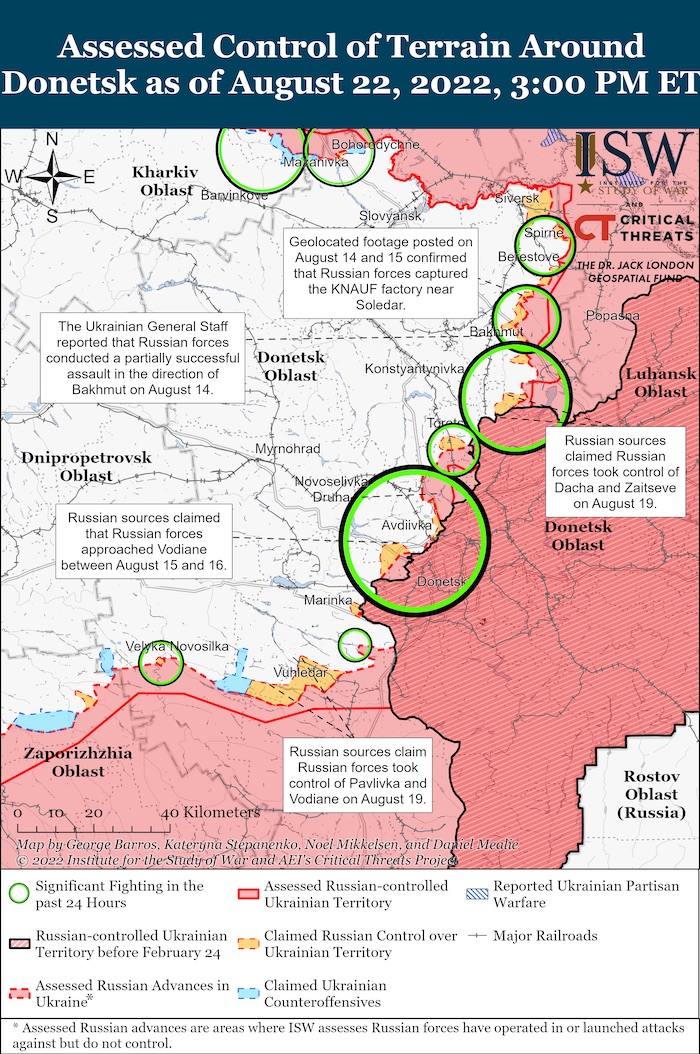
In the Donetsk direction, Russian forces are focused on conducting active actions in the Bakhmut and Avdiivka directions.
- In the Kramatorsk direction, shelling was recorded near Hryhorivka, Rozdolivka, Bilenke and Spirne. [Yesterday, shelling of the Siversk, Zakitne, Pereizne, Hryhorivka, Verkhnokamyanske and Pryshyb districts was recorded. In the area of Krasnopill settlement, Russian forces waged an offensive battle.]
- In the Bakhmut direction, the occupiers carried out fire damage near Bakhmut, Mayorsk, Soledar, Zaytseve, Shumy and Kodema. Russian forces tried to conduct combat reconnaissance in the area of Zaitseve settlement, as well as conduct assault operations near Soledar and Kodema, but were unsuccessful and retreated. [Yesterday, Russian forces shelled military and civilian infrastructure near Kostiantynivka, Bakhmutske, Pidhorodne, Yakovlivka, Vesela Dolyna, and Bilohorivka. It launched an airstrike on the positions of the defense forces in the Soledar area and rocket strikes in the areas of the settlements of Soledar and Kostiantynivka. It conducted assault operations near Soledar, Kodema and Zaitseve. There was no success.]
- In the Avdiivka direction, Russian forces used tanks, barrel artillery, and multiple rocket launcher systems in the areas of Vodyane, Novobakhmutivka, Krasnohorivka, Opytne, and Nevelske. Conducted an airstrike near Mariinka. It conducted an offensive near Krasnohorivka and Pervomaiske, but was unsuccessful. [Yesterday, Russian forces shelled the areas of Avdiivka, Oleksandropil, Mariinka, Pervomaiske and Pisky settlements with tanks and artillery of various types. He carried out airstrikes near Nevelske, Mariinka and Krasnohorivka. It conducted an offensive in the areas of Krasnohorivka, Pervomaiske and Nevelske]
- In the Novopavlivskyi direction, it shelled the areas of Pavlivka, Prechistivka, and Vugledar settlements. It conducted offensive battles in the areas of settlements of Novomykhailivka and Zolota Nyva, without success. [Yesterday, enemy fire was recorded near Novomykhailivka, Elizavetivka, and Novoukrainka. The occupiers carried out offensive actions in the Novomykhailivka area, suffered losses and retreated.]
- In the Zaporizhzhia direction, fire damage was recorded near Zaliznychne, Orikhiv, Chervone, Burlatske, Zelene Pole, Stepove, Novopavlivka, and Novoandriivka. It carried out airstrikes in the areas of Malinivka, Olhivske, Zaliznychne and Novopil settlements. [Yesterday, Russian forces fired artillery and rocket artillery and tanks in the areas of the settlements of Hulyaipole, Shevchenko, Charivne, Novosilka, Vremivka, Vilne Pole, Mala Tokmachka, Poltavka, Dorozhnyanka. It conducted an offensive near Vremivka and Velyka Novosilka.]
In the Pivdenny Buh direction, Russian forces are concentrating their main efforts on holding the occupied positions and preventing the advance of our troops. Takes measures to replenish losses. It carried out shelling from tanks and artillery of various types in the areas of settlements of Parutyne, Lymany, Lozove, Shevchenkove, Myrne, Ukrainka, Kiselivka, Potyomkyne, Shyroke, Ivanivka, Osokorivka, Dobryanka, Pryshyb, Kvitneve. Carried out airstrikes near Trudolyubivka, Potyomkine, and Andriivka. [Yesterday, they fired on civilian infrastructure in the areas of Velike Artakove, Mykolaiv, Andriivka, Posad-Pokrovske, Stepova Dolyna, Tavriyske, Bila Krynytsia, Partizanske, Luch, Tokareve, Kamiane, Novovorontsovka, Polyana, Novooleksandrivka and Lyubomirivka settlements. It carried out airstrikes near Andriyivka, Olgany, Trudolyubivka, and Potyomkyne, and missile strikes on Mykolaiv and Zatoka.]
- [To conduct aerial reconnaissance, the occupiers actively use UAVs.]
Russian naval group in the Black Sea and the Sea of Azov focuses its main efforts on blocking civilian shipping in the northwestern part of the Black Sea and damaging military facilities and infrastructure elements deep in the territory of Ukraine.”
Ukraine further damages bridges in Kherson, Nova Kakhovka; Bakhmut remains front’s hottest spot
Military Updates
Ukrainian intelligence issues warning regarding Independence Day, Ukrainska Pravda reports, citing Andrii Yusov, spokesman for the Defence Intelligence of Ukraine (DIU). "There is a heightened threat of missile strikes and other provocations, both from within the country and from the outside. Russia and Putin's regime have attacked Ukraine’s independence and independent Ukraine. They are obsessed with dates and symbols, so it would be perfectly reasonable to be particularly careful and prepared for the fact that Independence Day [celebration] will also come under attack."
Ukrainian intelligence insists that the state is prepared for a possible attack in the light of the fact that Russia still has a large number of missiles that can inflict a lot of damage.”
The US believes Russia is planning strikes on Ukraine's infrastructure soon, Reuters reports. “The United States has intelligence that Russia is planning to launch fresh attacks against Ukraine's civilian infrastructure and government facilities soon, a US official said on Monday.
We have information that Russia is stepping up efforts to launch strikes against Ukraine’s civilian infrastructure and government facilities in the coming days. Given Russia’s track record in Ukraine, we are concerned about the continued threat that Russian strikes pose to civilians and civilian infrastructure, the official said.”
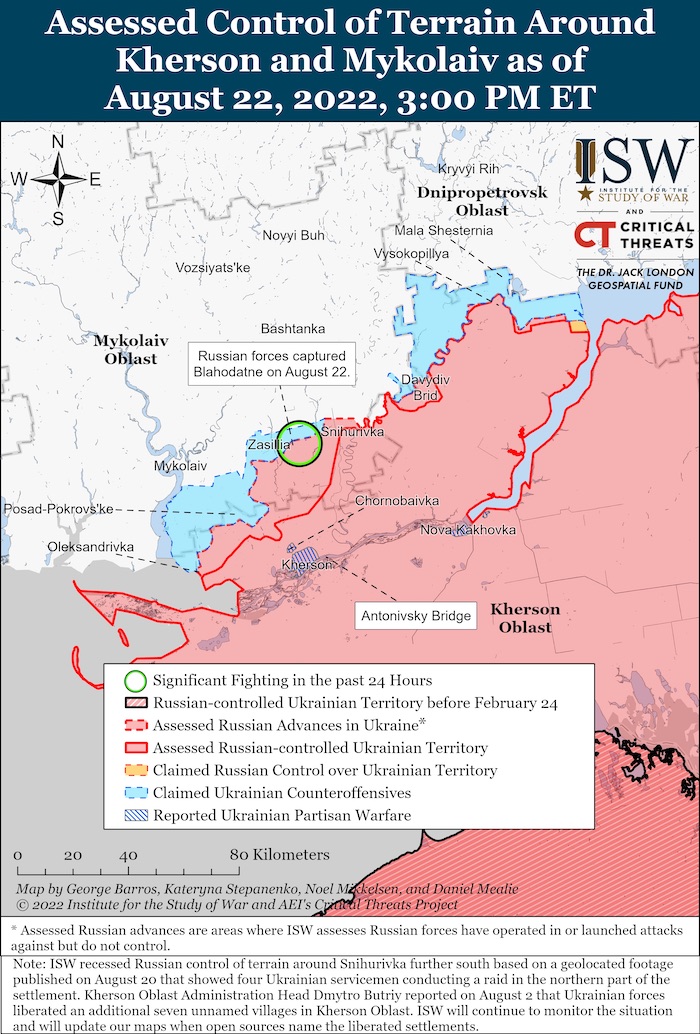
Explosions were heard in Sevastopol and Kherson, Ukrainska Pravda reported Monday evening, citing the Latvia-based Russian media outlet Meduza. “Residents of Sevastopol and Kherson report the sounds of explosions. Over the last few days, explosions have been periodically reported in Sevastopol, but no one has officially commented on them. Once Mikhail Razvozhayev, the so-called "governor of Sevastopol" reported that air defence was operating in the area of the city.
On 22 August, the occupying authorities of Sevastopol began checking bomb shelters after a number of explosions, despite the fact they had earlier insisted on the reliability of their air defence.”
According to British Defence Intelligence, (last 48 hours):
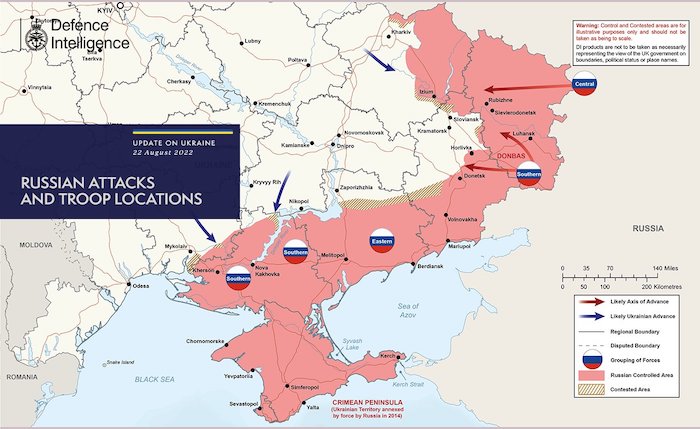
- Over the weekend, Russia probably started moving barges into position to construct a substantial floating bridge over the Dnipro river, immediately beside the damaged Antonivsky road bridge. The crossing is the key link between Russian-occupied Kherson and the east.
- For several weeks, Russian forces and local civilians have relied on a ferry crossing of the waterway. If Russia completes the improvised bridge, it will almost certainly increase the capacity of the crossing point compared to the ferry.
- A floating bridge would likely still be vulnerable to Ukrainian offensive action.
- On 15 August 22, Ukrainian social media channels circulated a video which reportedly showed elements from a military unit of the self-proclaimed Luhansk People’s Republic (LNR) delivering a declaration outlining their refusal to be deployed as part of offensive operations in Donetsk Oblast.
- The fighters claimed they had fulfilled their duty in securing the LNR’s control over all of Luhansk Oblast, which was secured in July 2022, and were unwilling to fight in Donetsk Oblast despite threats and intimidation by senior commanders.
- Russia is likely increasingly struggling to motivate the auxiliary forces it is using to augment its regular troops in the Donbas. Commanders are probably resorting to direct financial incentives, while some combat units are deemed unreliable for offensive operations. A consistent contributing factor to these problems is Russia’s classification of the war as a ‘special military operation’ which limits the state’s powers of legal coercion.
Losses of the Russian army
As of Tuesday 23 August, the approximate losses of weapons and military equipment of the Russian Armed Forces from the beginning of the war to the present day:
- Personnel – more than 45550 (+150),
- Tanks – 1921 (+2),
- Armoured combat vehicles – 4238 (+8),
- Artillery systems – 1033 (+1),
- Multiple rocket launchers –MLRS - 266 (+0),
- Air defence means – 146 (+1),
- Aircraft - 234 (+0),
- Helicopters - 198 (+0),
- Automotive technology and fuel tanks – 3150 (+1),
- Vessels/boats - 15 (+0),
- UAV operational and tactical level – 817 (+2),
- Special equipment – 99 (+0),
- Mobile SRBM system – 4 (+0),
- Cruise missiles – - 196 (+2)
Russian enemy suffered the greatest losses (of the last day) in the Donetsk direction.
Commander-in-Chief of Armed Forces of Ukraine announces losses: Almost 9,000 Ukrainian heroes, Ukrainska Pravda reports, citing Interfax-Ukraine. "This war involves not only military personnel and not only those who took up arms, but also our little children who are not guilty of anything at all, except that they were born right here and at this time.
They really do not understand anything that is happening, but they definitely need protection near Soledar, Bakhmut, Velyka Novosilka, and here, because their father went to the front and may be among almost 9,000 heroes who died
."
Over $3,000 for murdering Ukrainians: ISW reveals Russia’s pay to contractors, Ukrinform reports. “Members of the so-called "volunteer battalions" in Russia, who have agreed to deploy for the war in Ukraine are paid more than $3,000 a month. This is stated in the latest report by a Washington-based Institute for the Study of War.
It is noted that the said battalions are formed across Russian regions. Primorsky Krai offered recruits ages 18 to 60 a one-time enlistment bonus of 300,000 rubles (about $4,980) and monthly salaries of 200,000 rubles (about $3,320), ISW claims.”
⚰️russia's combat losses in Ukraine as of August 23
▪ 45550 killed soldiers (+150)
▪ 4238 APV (+8)
▪ 1921 tanks (+2)
▪ 1033 artillery systems (+1)
▪ 234 aircraft and 198 helicopters
▪ 15 boats and cutters#StopRussia #StandWithUkraine pic.twitter.com/ThlghHY3kO— VoxUkraine (@voxukraine) August 23, 2022
Humanitarian
Ukraine: Wide-scale armed conflict inflicts emotional pain on families of missing loved ones, the International Committee of the Red Cross reports. “Since end of February, the International Committee of the Red Cross (ICRC) has received more than 27,000 calls and emails from people looking for news of their loved ones who have been affected by the international armed conflict in Ukraine.
The ICRC has provided nearly 3,000 families affected by the conflict with news on the fate or whereabouts of their loved ones. The information provided to each of those families brings a profound sense of relief. But the fact is that many more families are waiting for news, particularly families of prisoners of war, who feel frustrated, hopeless, and angry as the days and months go by without any information.
"Over the last six months, the international armed conflict raging in Ukraine has caused a huge number of civilian deaths and injuries, massive population displacement, immense physical and mental suffering, and horrific damage to civilian infrastructure. It's also taken an extreme emotional toll on victims of conflict and families of soldiers," said Robert Mardini, the ICRC's director-general. "Families are anxious and desperate for news. We hear it in their voices and read it in their words. Conflict makes it clearer than ever that families belong together. We're determined and will continue to work as hard as we can to reconnect separated relatives."
The consequences of a missing family member can be devastating, and families have a right to know what happened to their loved ones.
Under the Third Geneva Convention, the states mandate the ICRC to visit prisoners of war in international armed conflicts, no matter where they are held. The ICRC continues to call on all relevant authorities to facilitate visits by the ICRC to prisoners of war, a stipulation all parties have agreed to under the Geneva Conventions.
The last six months have taken a huge toll. If frontlines continue to shift, more civilians will be subjected to the horrors of conflict, with lives needlessly lost and families torn apart. The Red Cross Red Crescent Movement is working to alleviate the suffering of victims of conflict, including by providing unconditional cash grants to 625,000 people.
Some of the other work that the ICRC, the Ukrainian Red Cross and other Red Cross and Red Crescent Movement partners, including the IFRC, have carried out since February includes:
- 8 million people have improved access to water
- 5 million people provided with basic assistance
- 984,000 people benefitted from hygiene supplies
- 718,000 people reached with health interventions
- 368,000 reached with mental health and psychosocial support
Ukraine's agricultural exports could rise to 4 million tonnes in August, Reuters reports. “Ukraine's agricultural exports are likely to rise to about 4 million tonnes in August, from 3 million tonnes in July, thanks to the UN-brokered deal that unblocked Ukrainian seaports, a deputy chair of the Ukrainian Agrarian Council said on Monday.
Denys Marchuk, whose organisation represents agricultural producers, told a televised briefing that despite new export opportunities, Ukrainian farmers would still face a shortage of funds and a third of them would not take part in 2022/23 winter grain sowing later this month.”

OHCHR recorded 13,477 civilian casualties in Ukraine as of August 22. 5,587 were killed (including 362 children) and 7,890 injured (including 610 children).
️️Environmental
Russia to convene UN Security Council meeting on Tuesday to discuss "situation at Zaporizhzhia Nuclear Power Plant", Ukrainska Pravda reports, citing Office of Permanent Representative of Ukraine to the UN in a comment for Ukrinform. “The Office of the Permanent Representative of Ukraine to the United Nations reported that the Russian Federation has requested to convene an urgent UN Security Council meeting to discuss "the situation around the Zaporizhzhia Nuclear Power Plant" (ZNPP).
Russia has requested that a Security Council meeting be convened on Tuesday, 23 August. This is another desperate attempt by the Russian delegation to use the UN Security Council's tools, first of all, to divert attention from the planned meeting on 24 August and, second, to blame Ukraine for the attacks on the ZNPP that Russia itself is regularly carrying out.
Russian media have earlier reported that the Russian Federation was urgently convening a Security Council meeting to discuss the situation at the ZNPP "related to relentless Ukrainian provocations". Russia has asked UN Secretary-General Antonio Guterres to give a speech during the meeting.”
Putin Wouldn’t Shrink from Starting Chernobyl 2.0 in Ukraine, The New York Times argues. “The history of warfare has no precedent for what is happening right now in Zaporizhzhia, Ukraine. Never before has a nuclear power plant been on the front line of a major war, and indeed a main object of the warring parties’ strategies. How Russia, Ukraine and the rest of the world handle this moment of peril is becoming a test of how war will be waged in our time — and whether it can ever be limited.
There are reports that Russian President Vladimir Putin has told his French counterpart, Emmanuel Macron, that the Kremlin would allow international monitors to visit the nuclear plant in question to guarantee its safety. If Putin means that, it would be encouraging. But he habitually lies about his intentions, as he did before his invasion of Ukraine half a year ago.
The plant, called ZNPP, is the largest in Europe. Before Putin’s attack, it supplied about one-fifth of Ukraine’s electricity. The Russians took it in March and have held it since. But the employees — originally about 11,000, many of whom have fled — are still Ukrainian. These engineers are now hostages. They’re keeping the reactors safe and running, but at gunpoint.
Tactically, the Russians are using ZNPP as a shield. They’re sheltering troops, weapons and ammo near the reactors and the stored nuclear waste on the assumption that the Ukrainians won’t dare to obliterate them with artillery, lest the explosions cause a radioactive leak or even a meltdown.
By firing from the plant at the Ukrainian troops across the Dnipro River, the Russians are also tying down the defender’s army and thereby slowing the Ukrainian counterattack to retake the country’s south.
Strategically, the Russians are planning to disconnect ZNPP from the Ukrainian electricity grid and link it to their own. In effect, they’re hoping to steal a large part of Ukraine’s power supply. This involves destroying — detonating, basically — the transmission lines at the plant, which is unbelievably dangerous.
The Ukrainians have the opposite objectives. They want to liberate their compatriots inside the plant. They want to keep its electricity flowing to Ukraine rather than to enemy-occupied regions. And they want to clear the plant of Russian occupiers so they can move on to retake the rest of southern Ukraine.
Above all, though, the Ukrainians want to prevent a nuclear catastrophe reminiscent of that at Chernobyl in 1986, just up the Dnipro. And they share this objective with the United Nations, the International Atomic Energy Agency, as well as countries in the West, East, South, North and middle — that is, with all of humanity. Presumably, that even includes people in the Kremlin.
The nature of the peril is what makes this situation unprecedented. A radioactive cloud in Zaporizhzhia would waft wherever the winds carry it. It could show up in western Europe, the Middle East, in Belarus, Russia, or somewhere else. Because such a disaster would be impossible to contain geographically, it would also be hard to limit militarily, strategically and geopolitically. It would spread panic far and wide, and could draw other countries into the conflict.
To prevent these horror scenarios, Mariano Grossi, director general of the IAEA, has repeatedly pleaded for a timeout in Zaporizhzhia to let the agency send a team of monitors to assure ZNPP’s safety. After a conference call with Macron over the weekend, the leaders of the US, UK and Germany also called on Putin to allow such an inspection.
One problem is that even though the situation is new, human nature is timeless. The first casualty in war is always the truth, as the old maxim has it. We know that things are exploding around ZNPP. But we can’t confirm who’s doing the shooting.
The Russians naturally blame the Ukrainians for the shelling. That seems implausible. Yes, the Ukrainians would, if they could, liberate the plant with special forces. But they’d hardly destroy a big source of their own electricity at the risk of releasing radioactivity in their own country — in effect, mass suicide.
The Ukrainians in turn say that the Russians are deliberately provoking an escalation, and even preparing to stage “false flag operations.” Given the track record of Putin, a KGB man who spent most of his career manipulating reality with disinformation and lies, I find this more plausible.
This points to another timeless problem made acute by this crisis. It’s the eternal tension described by Carl von Clausewitz, a Prussian veteran of the Napoleonic wars who became a philosopher on war. Even when generals want to keep conflict limited, war itself seems to want to become absolute.
The Ukrainians obviously don’t want to cede ZNPP to the Russians, for that would be a major setback in their existential struggle to preserve their nation. Putin, however, can’t afford to retreat from the plant, which would make a Russian victory in Ukraine — however he defines it nowadays — elusive. And defeat would probably spell his demise.
Since his senseless attack in February, Putin’s personal incentives do not align with those of Russians or people anywhere, least of all Ukrainians. He cares only about whether and how he goes down, not about how many others he’ll pull down with him. That’s why, if things go badly for him, Putin may yet decide to escalate, by using chemical or even nuclear weapons.
In the standoff at Zaporizhzhia, Putin — no matter what he tells Macron — might willingly incur the risk of nuclear meltdown in a country he wants to subjugate. The whole world, from Paris to Ankara and Beijing, must now steer him away from the brink. Success is not assured.»
Legal
Russia sends forcibly mobilized Ukrainians from occupied Donbas to die as ‘live bait’ at the frontline, Kharkiv Human Rights Protection Group reports. “Russia does not need to keep any record of how many Ukrainian men, forcibly mobilized from occupied Donbas, are killed in the fighting, nor pay compensation to the men’s families. According to Serhiy Haidai, Governor of the Luhansk oblast, the Russians […] actively send them onto the frontline “as bait, to calculate where the fire from the Ukrainian Armed Forces is coming from.” Anybody is sent, regardless of their state of health.
The Luhansk Regional Administration posted a video from the self-proclaimed and Russian-controlled ‘Luhansk people’s Republic’ [‘LNR’] on 21 August showing virtually only women and pensioners working at the Dovzhanska-Kapitalna coalmine. Nobody else remains after 430 miners were sent to the front. All of this is in breach of labour legislation, but the video tries to present it as something to be proud of, comparing it to the situation during the Second World War. Then, however, the Nazis invaded the Soviet Union, and every able-bodied man was needed to fight a savage invader. Here, the aggressor state, which is calling its full-scale invasion of Ukraine ‘a special operation’, is forcibly sending men from occupied territory to fight against their own fellow citizens, and probably be killed, as they are sent without any training. Russia’s use of fake ‘Republics’ is enabling it to gain men whose deaths effectively nobody accounts for, or even tries to record.”
#UkrainianPOWs beaten and threatened with execution if they didn’t ‘admit’ to #Russia bombing of #Mariupol#FreeAzovstalDefenders #Ukraine #Olenivka #StandWithUkraine #RussiaWarCrimes #StopRussia https://t.co/HWi7h1zlJF pic.twitter.com/Se9JykTFtL
— Halya Coynash (@halyapuff) August 22, 2022
Ukraine asks UN and Red Cross to document the show "trial" in Mariupol – ombudsman, Ukrainska Pravda reports. "We address once again to document this yet another violation of the Geneva Convention, another war crime on the part of the Russian Federation (show ‘trial’ in Mariupol - ed.), so that the documentation [of this crime] is done by both the United Nations and the International Committee of the Red Cross.
Lubinets added that he also appealed to the Russian ombudsman Tatyana Moskalkova to prevent another crime by the Russian occupiers, but he has not received an answer. According to Ukrainian intelligence, on the Independence Day of Ukraine, 24 August, the Russian occupiers plan to hold the sham "trial" of the captured defenders of Azovstal steel plant in the temporarily occupied Mariupol.”
374 children were killed, 723 children injured, 6958 deported by foe forces, and 226 reported missing - the Office of the Prosecutor General of Ukraine reports as of August 23. 2,328 educational establishments are damaged as a result of shelling and bombings, 289 of them are destroyed fully. 29,707 crimes of aggression and war crimes and 13,894 crimes against national security were registered.
Support
https://twitter.com/EuromaidanPress/status/1561811445188263936
A Ukrainian call to mark the anniversary of the independence of Ukraine: the global campaign #IndependenceInMyHeart - Is 6 months too much or too little? During this time, Ukrainians were able to unite the democratic world around the struggle for freedom and independence in the name of a free future world! For our independence and yours!
On August 24, activists in 59 cities of 26 countries in Europe, Asia, the USA, Canada and Australia will take to the streets to remind: preserving Ukraine's independence and restoring its territorial integrity is a key guarantee of future peace on the planet. And this is possible only through a complete victory over the terrorist country Russia. We invite everyone who, together with Ukrainians, understands the true value of freedom and democracy to join! Join the campaign organization in your city: https://forms.gle/WU6gbWtk71qWRUCi9
The complete list of cities and countries that joined the campaign: https://docs.google.com/.../1b_FR7jNxwYZ--_Nr6uckc.../edit
The US will send Switchblade 600 long-range kamikaze drones to Ukraine, Ukrainian Business News reports. “According to Pentagon spokeswoman Jessica Maxwell, a contract for developing and assembling Switchblade 600 drones by AeroVironment is expected within 30 days and then they will be shipped to Ukraine. The US has previously delivered the smaller Switchblade 300 and Phoenix Ghost drones to Ukraine’s military. The Switchblade 600 can fly more than 40 km and hover over a target for 40 minutes before engaging with an anti-tank warhead.”
The US might be sending Ukraine more weapons than announced, Ukrinform reports. “The United States may have provided Ukraine with more weapons than the Joe Biden administration has announced publicly, according to US experts Michael Weiss and James Rushton. The latest strikes that Ukraine delivered targeting Russian military facilities in occupied Crimea, far from the front lines, suggests such a possibility, Politico reports.
The publication notes that on Friday, a senior Pentagon official said the US had been quietly supplying the Ukrainians with High-speed Anti-Radiation missiles — used for targeting radar systems — for some time. According to Weiss and Rushton, another possibility is that the US has secretly sent the Army Tactical Missile System, or ATACMS, to Ukraine.
Also, it is known that the US included Excalibur precision-guided munitions in the August 19 weapons package, even though the administration didn’t publicly announce them. Furthermore, a document sent by the administration Friday to lawmakers, says what goes to Ukraine isn’t “limited” to what’s featured in the publicly released list of weapons supplied.”
https://twitter.com/EuromaidanPress/status/1561654892841803776
Kuleba names two EU countries that do not supply weapons to Ukraine, Ukrainska Pravda
reports, citing European Pravda. "With the exception of Hungary and Austria, as a neutral country, the supply of weapons to Ukraine is not a taboo for any European country, although it used to be, [the Minister of Foreign Affairs of Ukraine Dmytro Kuleba said].
The Minister of Foreign Affairs added that the political discussions of the Western partners about when and which weapons to transfer cost Ukraine daily losses on the front.”
German Ministry of Defence rejects vows to send Ukraine more weapons, European Pravda reports. “An official representative of the German Ministry of Defence said on Monday that the department has rejected a proposal from the Bundestag MPs from the ruling coalition to send Ukraine more weapons and, if necessary, to agree to the weakening of the Bundeswehr.
Indeed, we must be ready for Putin could exploit any weakness and even temporary gap in NATO's defence readiness, DW quotes the representative of the German Ministry of Defence. He reminded that Germany should provide its Alliance partners with "aid within the limits of obligations, as provided for in Article 5 of the North Atlantic Treaty. During the Cold War, we would probably have had little understanding if our allies had made cutbacks in collective defence under Article 5 of the NATO treaty elsewhere because of acute theaters of war - and there were, after all, in the world, added the representative of the German military department.
The day before, Defence politicians from the Greens, SPD, and FDP had demanded additional arms deliveries to Ukraine from the federal government, even if this could temporarily weaken the Bundeswehr.Earlier, the German mass media reported that for the past ten weeks, the German government has been ignoring Ukraine's requests for additional arms supplies.”
Poland passed Ukraine 5,000 Starlink antennas, Ukrainska Pravda reports. "Our Polish friends supplied Ukraine with 5,000 "Starlinks". It will help Ukrainians to always be in touch and will allow the critical infrastructure facilities to work in the harshest conditions. I am extremely grateful to Janusz Cieszyński, the State Secretary of Poland for digitalization, for taking such an important step, Mykhailo Fedorov, the Minister of Digital Transformation of Ukraine, on Facebook.”
Majority of Ukrainians consider only full liberation of all territories of Ukraine a victory, Ukrainska Pravda reports, citing results of a survey by "Deminitsiatyvy" ("Democratic Initiatives") and the Razumkov centre. "The majority of the participants (55%) say that they will consider a victory the liberation of all Ukrainian territories from the occupiers and returning the borders as of January 2014. 20.5% are even more radical – for them, victory will be the complete destruction of the Russian army and facilitation of the rebellion/disintegration in Russia.
A small percentage of the respondents will consider it a victory if the war ends with some concessions from the Ukrainian side. Nearly 9 percent of respondents consider a victory the liberation of all Ukrainian territory except the occupied Crimea; 7.5% will accept returning to the status-quo as of 23 February 2022, and 3% percent assume the war could end even if the occupiers stay in the territories invaded during the full-scale war.
Similarly, more than 75% of respondents will support the decision to terminate all relations with Russia and even ban Russians from entering Ukraine after its victory and liberation of all its territory.”
More than 90 percent of Ukrainians believe in victory over Russia, Ukrainska Pravda reports, citing the results of the survey by Democratic Initiatives Foundation and the Razumkov Centre. "More than 90% of respondents believe in Ukraine's victory in this war. (77% [said they were] confident and 15% rather confident). Only one percent of respondents do not believe or rather do not believe in victory.
31% of those who believe in victory hope it will happen before the end of this year. 34% believe that it will happen in a year or two. Another 7 percent believe that it will take from 3 to 5 years. Another 23% found it difficult to answer this question, and a few percent say that victory will happen in a very long-term run."
“Our will to help Ukraine must not leave us. It is also about our freedom and security. Let us not allow the aggressor to win,” Czech PM Petr Fiala said commemorating the 54th anniversary of Soviet-led Warsaw Pact troops invasion of Czehia https://t.co/IwbW8eHDjz
— Euromaidan Press (@EuromaidanPress) August 22, 2022
New Developments
Russians from Moscow, Kursk documented their own crimes, now identified
While Tsyrkuny village was occupied, Russians broke into a house, stole a phone & filmed how they looted. Videos appeared in the owner’s cloud storage https://t.co/xdmIhv9ZSUpic.twitter.com/tW33BvzN6o
— Euromaidan Press (@EuromaidanPress) August 23, 2022
- There will be no talks with Russia if it holds show trials, Zelensky says, The New York Times “President Volodymyr Zelensky of Ukraine threatened on Sunday to cut off all negotiations with Russia if Ukrainian prisoners of war are paraded in the captured city of Mariupol and put on what he called an absolutely disgusting and absurd show trial. He previously said he would cut off negotiations if Moscow annexed newly captured territories.”
- Russia rules out peace deal to end Ukraine war, Financial Times “Moscow sees no possibility of a diplomatic solution to end the war in Ukraine and expects a long conflict, a senior Russian diplomat has warned […]. Now, I do not see any possibility for diplomatic contacts, Gatilov said. And the more the conflict goes on, the more difficult it will be to have a diplomatic solution. We do not have any contacts with the western delegations, he said of his day-to-day work in Geneva. On the protocol side we do not see each other … Privately we do not have any contacts, unfortunately … we simply do not talk to each other. Global diplomacy was in the worst state he had experienced in his 50-year career, Gatilov added”.
https://twitter.com/EuromaidanPress/status/1561883922664812544
- This is not Putin's war, this is Russians’ war - Polish Foreign Ministry, Ukrinform reports, citing Radio Poland. "This is not Putin's war because Putin is not fighting this war, the Russians are fighting this war. If their families fail to understand this, if their relatives cannot understand what’s happening in Ukraine, I think they should also bear responsibility. Because had Putin not enjoyed public support, he probably would not have waged this war. Despite everything, he is sensitive to how Russians perceive his policies, Deputy Minister of Foreign Affairs of Poland, Piotr Wawrzyk, said.”
Seeking a diplomatic agreement with Putin is amoral, senseless and dangerous, Russian analysts say
- First document on security guarantees for Ukraine will appear by the end of the summer, Ukrainska Pravda reports, citing Andrii Yermak, the head of the Office of the President. "I confirm that by the end of this month – somewhere around the 29-30th of August – we can already expect the first document containing the recommendations of our group of experts together with Mr Rasmussen [former Secretary General of NATO – ed.] to appear.”
- Russia accuses Ukraine of killing the nationalist's daughter, Reuters “Russia's Federal Security Service accused Ukraine's secret services on Monday of killing Darya Dugina, the daughter of an ultra-nationalist, in a car bomb attack near Moscow that President Vladimir Putin called "evil". Dugina, whose father Alexander Dugin is a prominent ideologue, was killed on Saturday when a bomb blew up the Toyota Land Cruiser she was driving, Russian investigators said.”
https://twitter.com/EuromaidanPress/status/1561800623942537217
- MFA Estonia decries FSB version of propaganda pundit’s kill “provocation”, Ukrinform reports, citing ERR. Minister of Foreign Affairs of Estonia, Urmas Reinsalu, says the Russian security agency’s version of the murder of propagandist Daria Dugina, where the suspect is a Ukrainian woman Natalia Vovk, who allegedly “escaped to Estonia,” is a provocation. The top diplomat noted that Russia is trying to put pressure on Estonia over its support for Ukraine. Why is Estonia now experiencing the largest cyber attacks since the ‘Bronze Nights?’ Why did the former president of Russia say two weeks ago that it is their fault that Estonia is still a free country? I think that all these events and various actions are part of a wider context, and the purpose of this is to exert unambiguous pressure by various tools on Estonia and a number of other countries supporting Ukraine. Estonia views the statements of the FSB as a provocation by the Russian Federation. We have nothing more to add to this, Reinsalu said.”
Assessment
- On the war.
The Institute for the Study of War has made the following assessment as of Saturday 22 August, 2022:
“Russian occupation officials in Zaporizhzhia Oblast have obliquely declared the region’s independence from Ukraine by falsely identifying Ukrainian citizens entering the occupied region as temporary asylum seekers. Head of the Zaporizhzhia Oblast occupation administration Yevheny Balitsky signed an order that designates Ukrainian citizens arriving in occupied Zaporizhzhia Oblast as temporary asylum seekers based on Russian law. The order requires the registration of Ukrainian and Russian citizens based on their place of residence or place of arrival in the Russian-occupied parts of Zaporizhzhia Oblast and requires the distribution of temporary identification forms for all “stateless persons.” Ukrainians and Russians may register if they present proof of their temporary asylum application. This decree has various implications under both international law and domestic Russian law. International law states that a refugee is an individual from outside the country (or who is stateless) who is seeking “temporary asylum” in another country to escape persecution. Russian law defines a refugee as a person ”who is outside of his/her country of nationality or habitual residence.” Neither of these statuses properly apply to the majority of people crossing from unoccupied Ukraine into occupied Zaporizhzhia.
Russian occupation authorities are thus falsely classifying all Ukrainians entering occupied territories in Zaporizhzhia Oblast as refugees escaping persecution in Ukraine. The order also de facto identifies Ukraine as a separate country from the Zaporizhzhia Oblast entity, as defined by the occupation authority. By classifying all Ukrainians as refugees, Russian occupation authorities are establishing a new legal category that might have its own restrictions. Russian occupation authorities may use the refugee status to restrict Ukrainians who temporarily return to occupied territories after evacuating from them. The order will likely affect Ukrainian citizens traveling to occupied Kherson Oblast via the checkpoint in Vasylivka, Zaporizhzhia Oblast, as the order requires the registration of individuals at the point of arrival in the occupied Zaporizhzhia Oblast, and Vasylivka is the checkpoint serving Kherson as well as Zaporizhzhia Oblasts.
Key Takeaways
- Russian-backed occupation authorities in Zaporizhzhia Oblast have obliquely declared the independence of the occupied areas of the oblast by falsely identifying Ukrainian citizens entering from unoccupied Ukraine as temporary asylum seekers.
- Russian forces conducted localized spoiling attacks southwest and southeast of Izium.
- Russian forces continued ground attacks southeast of Siversk and northeast and south of Bakhmut.
- Russian forces continued attempts to advance from the northern and western outskirts of Donetsk City and conducted limited ground attacks southwest of Donetsk City.
- Russian forces made marginal gains along the Mykolaiv-Kherson line.
- Ukrainian intelligence stated that the Luhansk People’s Republic (LNR) will start “general mobilization” processes on September 1.
- Prymorsky Krai announced the formation of a new repair and service volunteer battalion.
Ukrainian partisans continued to conduct attacks against Russian forces in occupied Melitopol."
Key weapons of Ukrainian Navy in first days of war were mines and Bayraktars — Commander of Ukrainian Navy, Ukrainska Pravda reports. Rear Admiral Oleksii Neizhpapa in an interview published by the Naval Forces of the Armed Forces of Ukraine, on Facebook. "Mentally, we were all ready, preparing for this. Ships of the Naval Forces were withdrawn from their bases, ship-tactical groups served at sea. Artillery groups were formed on the shore, which were in cooperation with technical intelligence tools to detect Russian surface targets. Neizhpapa said that mines at that time were the most powerful weapon that the Navy had – "and it was used."
It was necessary to mine the landing-accessible areas in order to prevent Russia from landing tactical troops. To understand how to repel Russians, you need to have situational awareness of what is happening at sea – to make the right decisions. The task was to disperse the ships and carry out radar patrols. At night, everyone went to sea on schedule, despite the high risk of being drowned. Ships went to sea – and now they are going out to go ahead and see where the Russian invaders are.
In the first days of the war, the Ukrainian Navy was also greatly helped by Bayraktar drones. The Bayraktar Squadron played a key role, working, in particular, in Kherson Oblast and over the Black Sea. According to Neizhpapa, everything that could fly was used to the fullest."
According to Neizhpapa, the Black Sea fleet of the Russian Federation is a strong opponent. And they believe that Ukraine does not have a military fleet. But "military anger" helped the Ukrainians, so even boats managed to shoot down cruise missiles and planes.”
2. Consequences and what to do?
Since the very start of the full-scale invasion, I have repeatedly stressed that the war will cause a “tsunami of ripple effects” (e.g. costs of living, food and energy insecurity, famine, recession, inflation, and more) increasing the likelihood of global unrest, riots, and collapse of the governments. I fear that the political landscape in both the USA and Europe will change in the time to come as voters grows increasingly frustrated.
Six months after the invasion– and 8,5 years after the war – started, the following reports are only some samples of the “tsunami” having reached our shores:
Global inflation will increase due to Russia’s aggression against Ukraine, Ukrainian Business News reports. “The full-scale war launched by Russia against Ukraine has significantly impacted the world economy. The world’s economic growth rate has slowed, and inflationary processes have accelerated. According to the IMF, due to the war in Ukraine, the forecast indicators of annual inflation increased from 4.9% to 9.5% for the economies of developing countries and from 2.3% to 6.6% in developed countries. Forecast indicators of global economic growth in 2022 decreased from 4.9% to 3.2% as a result of the war in Ukraine.”
German recession increasingly likely, Bundesbank says, Reuters reports. “A recession in Germany, the euro zone's biggest economy, is increasingly likely and inflation will continue to accelerate and could peak at more than 10% this autumn, the Bundesbank said in a monthly report on Monday. With its oversized industry heavily exposed to Russian gas, Germany is among the most vulnerable to any cut off in energy supplies and soaring costs are already weighing on output with more pain expected.
High prices and a shortage of gas are already forcing Germany to curtail consumption, with energy intensive sectors from metal output to fertilizer production suffering heavily. Energy costs will meanwhile keep pushing inflation higher and a peak is unlikely before the autumn at around five times the European Central Bank's 2% target. Overall, the inflation rate could reach 10% in autumn, the Bundesbank said. "The upside risk for inflation is high, in particular in the event of a complete stoppage of gas supplies from Russia."
After Gazprom’s statement, the price of gas soared to $3,000, Ukrainian Business News reports. “Russia’s Gazprom announced that it was suspending the operation of Nord Stream 1 for three days, from August 31 to September 2, allegedly due to repairs. As a result, Monday’s gas price on the European market exceeded the $3,000 per thousand cubic meters mark. The price of September TTF futures on the ICE Futures exchange reached $3,240 per thousand cubic meters. A week ago, Gazprom voiced expectations that gas prices will rise to $4,000 per thousand cubic meters in the winter quotations. The record gas price in Europe was recorded on March 7, when the price soared to $3,898 per thousand cubic meters.”
Today's assessment will be published as a separate article.



